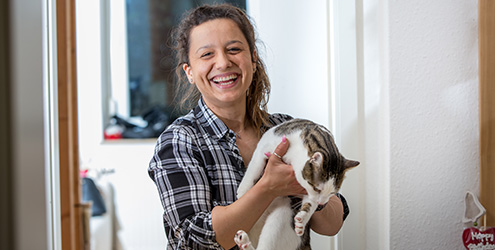Life-threatening bleeding
She was scared and didn't know what was happening to her and her body when she suddenly vomited blood. Joanna Korbi had a blood clot in the portal vein of her liver and her blood was backing up. The physicians at the Department of Medicine II were able to help the young woman with a shunt.

Joanna Korbi was not feeling well when she came home with her boyfriend that spring evening. She tried to sleep, but was unable to do so. She felt nauseous, ran to the bathroom and vomited blood. She was sweating, felt numb and could no longer see properly. Her friend called an ambulance, which took her to the University Emergency Center.
Extensive examinations followed: blood tests, X-rays, ECG and finally a gastroscopy, which revealed varicose veins in the oesophagus as a possible source of bleeding. The 24-year-old's condition remained critical. She was admitted to the Department of Medicine II as an inpatient. Here, experts in gastroenterology and hepatology carried out further examinations in order to find a diagnosis.
Joanna suffered from chronic portal vein thrombosis and associated variceal bleeding. The portal vein normally collects blood from the stomach, intestines, gallbladder and spleen and transports it into the liver. It then flows from the liver via the inferior vena cava to the heart. In Joanna's case, a blood clot had formed in the portal vein. As a result, the blood flow was disturbed and the gastric and oesophageal veins developed varicose veins. These heavily strained veins can rupture and cause life-threatening bleeding.
Take your time and explain the procedure in detail
Using a gastroscopy, in which a tube with a camera is inserted into the oesophagus, the doctors identified the varicose veins as the source of the bleeding and were then able to confirm the diagnosis of portal vein thrombosis using ultrasound and MRI of the abdomen. Even after hospitalization, there was initially further bleeding. It was now important to stabilize the young woman and stop the bleeding.
A common procedure for this is to tie the varices with an elastic band to close the tear. However, this does not solve the problem of portal vein thrombosis. "I was scared for my life and didn't know what was happening," says Joanna. "I remember having bloody bowel movements and vomiting blood in gushes." Then Dr. Michael Schultheiß, senior physician at the Department of Medicine II, took time for her. "He told me that there was a way to treat the thrombosis. Dr. Schultheiß explained the procedure to me in detail and even drew a picture to explain it better."

The doctor recommends that Joanna has a transjugular intrahepatic portosystemic shunt - TIPS for short - inserted. In a minimally invasive procedure, a detour is created from the portal vein directly to the draining hepatic veins, thereby relieving the blood congestion. At the same time, the conditions are created so that as much blood as possible can flow through the liver and be detoxified there despite the detour. TIPS is a routine procedure and is often performed on patients with liver cirrhosis and abdominal fluid or variceal bleeding. "In the case of chronic portal vein thrombosis, however, the procedure is technically much more difficult. That's why the procedure is often unsuccessful. But in Mrs. Korbi's case, there was no other good option to permanently control the life-threatening bleeding," explains the physician.
The procedure was successful. Joanna has had no more bleeding since then. "I'm healthy again and I'm doing sport again." However, she will probably still need a while to come to terms with what she has experienced. "Of course, I'm still afraid sometimes that the bleeding might come back. But then I try to think about something else, such as the fact that I want to start training in nursing care in September."
Corporate Communications
Breisacher Straße 153
79110 Freiburg
Phone: 0761 270-84830
Fax: 0761 270-9619030
kommunikation@uniklinik-freiburg.de

